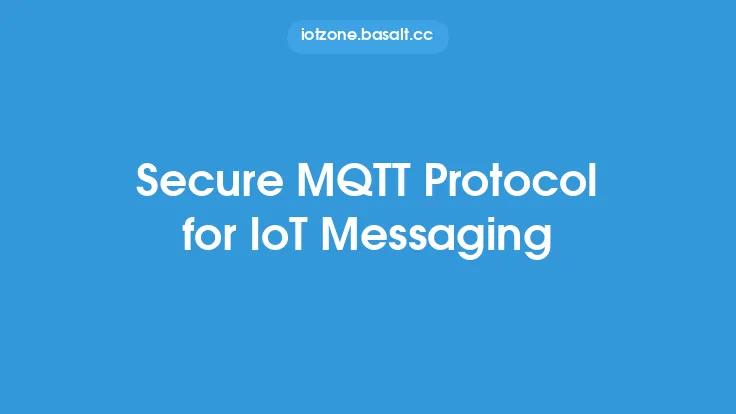The Internet of Things (IoT) has revolutionized the way we live and interact with devices, from smart home appliances to industrial sensors and actuators. As the number of IoT devices continues to grow, so does the concern for their security. One of the most critical aspects of IoT security is the use of secure protocols for communication between devices. In this article, we will delve into the world of secure protocols for IoT devices, exploring the various options available, their characteristics, and the importance of selecting the right protocol for specific use cases.
Secure Communication Protocols Overview
Secure communication protocols are designed to protect the confidentiality, integrity, and authenticity of data exchanged between IoT devices. These protocols use various techniques, such as encryption, authentication, and access control, to prevent unauthorized access, eavesdropping, and tampering with data. The choice of protocol depends on the specific requirements of the IoT application, including the type of devices, network infrastructure, and performance constraints. Some of the key considerations when selecting a secure protocol for IoT devices include the level of security required, the computational resources available on the devices, and the communication patterns between devices.
Key Characteristics of Secure Protocols for IoT
Secure protocols for IoT devices should possess certain key characteristics to ensure the confidentiality, integrity, and authenticity of data. These characteristics include:
- Encryption: The use of encryption algorithms, such as AES or RSA, to protect data from unauthorized access.
- Authentication: The use of authentication mechanisms, such as digital signatures or message authentication codes, to verify the identity of devices and ensure that data comes from a trusted source.
- Access control: The use of access control mechanisms, such as role-based access control or attribute-based access control, to restrict access to data and devices.
- Key management: The use of key management protocols, such as Diffie-Hellman key exchange or public key infrastructure, to securely manage cryptographic keys.
- Scalability: The ability of the protocol to support a large number of devices and scale with the growth of the IoT network.
- Performance: The ability of the protocol to provide low latency and high throughput, even in resource-constrained devices.
Secure Protocol Options for IoT
Several secure protocol options are available for IoT devices, each with its strengths and weaknesses. Some of the most commonly used protocols include:
- IPsec: A suite of protocols that provides encryption, authentication, and access control for IP networks.
- TLS: A protocol that provides encryption, authentication, and access control for TCP/IP networks.
- DTLS: A protocol that provides encryption, authentication, and access control for UDP/IP networks.
- CoAP: A protocol that provides encryption, authentication, and access control for constrained networks.
- LWM2M: A protocol that provides device management and security features for IoT devices.
- MQTT: A protocol that provides encryption, authentication, and access control for messaging between IoT devices.
Protocol Selection Criteria
The selection of a secure protocol for IoT devices depends on several factors, including:
- Device capabilities: The computational resources, memory, and power consumption of the devices.
- Network infrastructure: The type of network, such as wired or wireless, and the communication patterns between devices.
- Security requirements: The level of security required, including the type of threats and the potential impact of a security breach.
- Performance requirements: The required latency, throughput, and reliability of the communication.
- Scalability: The expected growth of the IoT network and the need for the protocol to scale with it.
Implementation and Deployment
The implementation and deployment of secure protocols for IoT devices require careful consideration of several factors, including:
- Key management: The secure management of cryptographic keys, including key generation, distribution, and revocation.
- Device configuration: The configuration of devices to use the selected protocol, including the setup of encryption, authentication, and access control mechanisms.
- Network configuration: The configuration of the network infrastructure to support the selected protocol, including the setup of firewalls, routers, and switches.
- Testing and validation: The testing and validation of the protocol implementation to ensure that it meets the required security and performance standards.
Conclusion
In conclusion, secure protocols for IoT devices are essential for protecting the confidentiality, integrity, and authenticity of data exchanged between devices. The selection of a secure protocol depends on several factors, including device capabilities, network infrastructure, security requirements, performance requirements, and scalability. By understanding the key characteristics of secure protocols and the available protocol options, IoT developers and deployers can make informed decisions about the best protocol to use for their specific use case. Additionally, careful consideration of implementation and deployment factors, such as key management, device configuration, network configuration, and testing and validation, is crucial for ensuring the secure and reliable operation of IoT devices.





